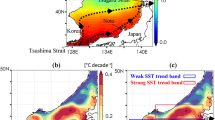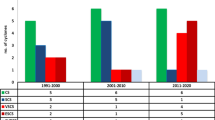Abstract
The storm surge and hydrodynamics along the Krishna–Godavari (K–G) basin are examined based on numerical experiments designed from assessing the landfalling cyclones in Bay of Bengal (BoB) over the past 38 years with respect to its highest maximum sustained wind speed and its duration. The model is validated with the observed water levels at the tide gauge stations at Visakhapatnam during 2013 Helen and 2014 Hudhud. Effect of gradual and rapid intensification of cyclones on the peak water levels and depth average currents are examined and the vulnerable locations are identified. The duration of intensification of a rapidly intensifying cyclone over the continental shelf contributed to about 10–18% increase in the peak water levels, whereas for the gradually intensifying cyclone the effect is trivial. The inclusion of the wave-setup increased the peak water levels up to 39% compared to those without wave-setup. In the deep water region, only rapidly intensifying cyclones affected the peak MWEs. Intensification over the continental slope region significantly increases the currents along the shelf region and coast. The effect on peak maximum depth averaged current extends up to 400 km from the landfall location. Thus, it is necessary to consider the effect of various combinations of the highest cyclone intensity and duration of intensification for identifying the worst scenarios for impact assessment of coastal processes and sediment transport. The study is quite useful in improving the storm surge prediction, in preparedness, risk evaluation, and vulnerability assessment of the coastal regions in the present changing climate.

(Source: Cyclone eAtlas-IMD 2020)





















Similar content being viewed by others
References
Albert J, Bhaskaran PK (2020) Evaluation of track length, residence time and translational speed for tropical cyclones in the North Indian ocean. ISH J Hydraul Eng 2020:1–8. https://doi.org/10.1080/09715010.2020.1825124
API (2003) Recommended practice for planning, designing and constructing fixed offshore platforms—working stress design
Atkinson JH, Westerink JJ, Luettich RA (2004) Two-dimensional dispersion analyses of finite element approximations to the shallow water equations. Int J Numer Methods Fluids 45:715–749. https://doi.org/10.1002/fld.701
Balaguru K, Taraphdar S, Leung LR, Foltz GR (2014) Increase in the intensity of postmonsoon Bay of Bengal tropical cyclones. Geophys Res Lett 41:3594–3601. https://doi.org/10.1002/2014GL060197
Balaguru K, Foltz GR, Leung LR (2018) Increasing magnitude of hurricane rapid intensification in the central and Eastern Tropical Atlantic. Geophys Res Lett 45:4238–4247. https://doi.org/10.1029/2018GL077597
Battjes JA (1972) Radiation stresses in short-crested waves. J Mar Res 30:1–56
Bhatia KT, Vecchi GA, Knutson TR et al (2019) Recent increases in tropical cyclone intensification rates. Nat Commun 10:1–9. https://doi.org/10.1038/s41467-019-08471-z
Booij N, Ris RC, Holthuijsen LH (1999) A third-generation wave model for coastal regions 1. Model description and validation. J Geophys Res Ocean 104:7649–7666. https://doi.org/10.1029/98JC02622
Courant R, Friedrichs KO, Lewy H (1928) Uber die partiellen differenzangleichungen der mathematisches. Math Ann 100:32–74
Cyclone eAtlas-IMD (2020) Tracks of cyclones and depressions over North Indian Ocean (from 1891 onwards), Chennai
Cyriac R, Dietrich JC, Fleming JG et al (2018) Variability in coastal flooding predictions due to forecast errors during Hurricane Arthur. Coast Eng 137:59–78. https://doi.org/10.1016/j.coastaleng.2018.02.008
DGH (2015) Krishna Godavari—basin NDR—national data repository India. https://www.ndrdgh.gov.in/NDR/?page_id=647
Dietrich JC, Zijlema M, Westerink JJ et al (2011) Modeling hurricane waves and storm surge using integrally-coupled, scalable computations. Coast Eng 58:45–65. https://doi.org/10.1016/j.coastaleng.2010.08.001
Dietrich JC, Tanaka S, Westerink JJ et al (2012) Performance of the unstructured-mesh, SWAN+ ADCIRC model in computing hurricane waves and surge. J Sci Comput 52:468–497. https://doi.org/10.1007/s10915-011-9555-6
Dvorak VF (1975) Tropical cyclone intensity analysis and forecasting from satellite imagery. Mon Weather Rev 103:420–430
Elsner JB, Kossin JP, Jagger TH (2008) The increasing intensity of the strongest tropical cyclones. Nature 455:92–95. https://doi.org/10.1038/nature07234
Garratt JR (1977) Review of drag coefficients over oceans and continents. Mon Weather Rev 105:915–929. https://doi.org/10.1175/1520-0493(1977)105
Holland GJ (1980) An analytic model of the wind and pressure profiles in Hurricanes. Mon Weather Rev 108:1212–1218
Holland GJ, Belanger JI, Fritz A (2010) A revised model for radial profiles of Hurricane winds. Mon Weather Rev 138:4393–4401. https://doi.org/10.1175/2010MWR3317.1
INCOIS (2020) What is the vulnerability of our coastline from the point of view of storm surge potential? In: ESSO- Indian Natl. Cent. Ocean Inf. Serv. (INCOIS), Govt India. https://incois.gov.in/portal/Aboutstormsurge.jsp
IPCC (2019) IPCC special report on the ocean and cryosphere in a changing climate. In: Pörtner H-O, Roberts DC, Masson-Delmotte V, Zhai P, Tignor M, Poloczanska E, Mintenbeck K, Alegría A, Nicolai M, Okem A, Petzold J, Rama B, Weyer NM (eds). In press
Irish J, Resio D, Ratcliff J (2008) The influence of storm size on hurricane surge. J Phys Oceanogr 38:2003–2013. https://doi.org/10.1175/2008JPO3727.1
Jain I, Rao AD, Jitendra V, Dube SK (2010) Computation of expected total water levels along the East Coast of India. J Coast Res 26:681–687. https://doi.org/10.2112/08-1170.1
JTWC (2020) North Indian Ocean best track data. In: Jt. Typhoon Warn. Cent. (JTWC), Off. U.S. Navy Website. https://www.metoc.navy.mil/jtwc/jtwc.html?north-indian-ocean
Kallepalli A, Kakani NR, James DB, Richardson MA (2017) Digital shoreline analysis system—based change detection along the highly eroding Krishna–Godavari delta front. J Appl Remote Sens 11:036018-1–11. https://doi.org/10.1117/1.JRS.11.036018
Keim B, Sathiaraj D, Brown V (2020) SURGEDAT: the World’s Storm Surge Data Center. In: South. Clim. Impacts Plan. Progr. http://surge.srcc.lsu.edu/index.html
Knapp KR, Kruk MC (2010) Quantifying interagency differences in tropical cyclone best-track wind speed estimates. Mon Weather Rev 138:1459–1473. https://doi.org/10.1175/2009MWR3123.1
Kolar RL, Gray WG, Westerink JJ, Luettich RA Jr (1994) Shallow water modeling in spherical coordinates: equation formulation, numerical implementation, and application. J Hydraul Res 32:3–24. https://doi.org/10.1080/00221689409498786
Li A, Guan S, Mo D et al (2020) Modeling wave effects on storm surge from different typhoon intensities and sizes in the South China Sea. Estuar Coast Shelf Sci 235:106551. https://doi.org/10.1016/j.ecss.2019.106551
Longuet-Higgins MS, Stewart RW (1964) Radiation stresses in water waves; a physical discussion with applications. Deep Res Oceanogr Abstr 11:529–562
Lynch DR, Gray WG (1979) A wave equation model for finite element tidal computations. Comput Fluids 7:207–228. https://doi.org/10.1016/0045-7930(79)90037-9
Mcinnes KL, Walsh KJE, Hubbert GD, Beer T (2003) Impact of sea-level rise and storm surges in a coastal community. Nat Hazards 30:187–207. https://doi.org/10.1023/A:1026118417752
Mei W, Pasquero C, Primeau F (2012) The effect of translation speed upon the intensity of tropical cyclones over the tropical ocean. Geophys Res Lett 39:7. https://doi.org/10.1029/2011GL050765
Poulose J, Rao AD, Dube SK (2020) Mapping of cyclone induced extreme water levels along Gujarat and Maharashtra coasts: a climate change perspective. Clim Dyn 55:3565–3581. https://doi.org/10.1007/s00382-020-05463-4
Rao AD, Chittibabu P, Murty TS et al (2007) Vulnerability from storm surges and cyclone wind fields on the coast of Andhra Pradesh, India. Nat Hazards 41:515–529. https://doi.org/10.1007/s11069-006-9047-4
Rao KN, Subraelu P, Rao TV et al (2008) Sea-level rise and coastal vulnerability: an assessment of Andhra Pradesh coast, India through remote sensing and GIS. J Coast Conserv 12:195–207. https://doi.org/10.1007/s11852-009-0042-2
Rao AD, Murty PLN, Jain I et al (2013) Simulation of water levels and extent of coastal inundation due to a cyclonic storm along the east coast of India. Nat Hazards 66:1431–1441. https://doi.org/10.1007/s11069-012-0193-6
Rego JL, Li C (2009) On the receding of storm surge along louisiana’ s Low-Lying Coast. J Coast Res SI 56:1045–1049. https://www.jstor.org/stable/25737946
Resio DT, Westerink JJ (2008) Modeling the physics of storm surges. Phys Today 9:33–38
Resio DT, Irish JL, Westerink JJ, Powell NJ (2013) The effect of uncertainty on estimates of hurricane surge hazards. Nat Hazards. https://doi.org/10.1007/s11069-012-0315-1
Sahoo B, Bhaskaran PK (2018) A comprehensive data set for tropical cyclone storm surge-induced inundation for the east coast of India. Int J Climatol 38:403–419. https://doi.org/10.1002/joc.5184
Sebastian A, Proft J, Dietrich JC et al (2014) Characterizing hurricane storm surge behavior in Galveston Bay using the SWAN+ADCIRC model. Coast Eng 88:171–181. https://doi.org/10.1016/j.coastaleng.2014.03.002
Sebastian M, Behera MR, Murty PLN (2019) Storm surge hydrodynamics at a concave coast due to varying approach angles of cyclone. Ocean Eng 191:1–16. https://doi.org/10.1016/j.oceaneng.2019.106437
Sebastian M, Behera MR (2015) Impact of SST on tropical cyclones in North Indian Ocean. In: Procedia Engineering. Elsevier B.V., pp 1072–1077. https://doi.org/10.1016/j.proeng.2015.08.346
Sebastian M, Behera MR (2018) Surge Height and Current Estimation Along K-G Basin. In: Proceedings of the International Conference on Offshore Mechanics and Arctic Engineering—OMAE. American Society of Mechanical Engineers, Madrid, Spain., pp 1–9. https://doi.org/10.1115/OMAE2018-77945
Sindhu B, Unnikrishnan AS (2012) Return period estimates of extreme sea level along the east coast of India from numerical simulations. Nat Hazards 61:1007–1028. https://doi.org/10.1007/s11069-011-9948-8
Singh VK, Roxy MK (2020) A review of the ocean-atmosphere interactions during tropical cyclones in the north Indian Ocean. arXiv:2012.04384
Thomas A, Dietrich JC, Asher TG et al (2019) Influence of storm timing and forward speed on tides and storm surge during Hurricane Matthew. Ocean Model 137:1–19. https://doi.org/10.1016/j.ocemod.2019.03.004
Willoughby HE, Rahn ME (2004) Parametric representation of the primary Hurricane vortex. Part I : observations and evaluation of the Holland (1980) model. Mon Weather Rev 132:3033–3048. https://doi.org/10.1175/MWR2831.1
Wu L, Wen Z, Huang R (2020) Tropical cyclones in a warming climate. Sci China Earth Sci. https://doi.org/10.1007/s11430-019-9574-4
Zijlema M (2010) Computation of wind-wave spectra in coastal waters with SWAN on unstructured grids. Coast Eng 57:267–277. https://doi.org/10.1016/j.coastaleng.2009.10.011
Acknowledgements
The first author would like to thank the financial support from the Industrial Research & Consultancy Centre (07IR001) and Department of Civil Engineering (DF/1111020) at Indian Institute of Technology (IIT) Bombay for carrying out this work. All the simulations were carried out at the High Performance computing facility at IIT Bombay, hence we also acknowledge the SpaceTime-2 supercomputing facility at IIT Bombay for the computing time. We wish to thank the Earth System Science Organization (ESSO)-Indian National Centre for Ocean Information Services (INCOIS), India for providing the observed tide gauge data free of cost.
Funding
Industrial Research & Consultancy Centre (07IR001) and Department of Civil Engineering (DF/1111020) at Indian Institute of Technology (IIT) Bombay.
Author information
Authors and Affiliations
Corresponding author
Ethics declarations
Conflicts of interest
The authors declare that they have no known conflicts of interest/competing interests.
Additional information
Publisher's Note
Springer Nature remains neutral with regard to jurisdictional claims in published maps and institutional affiliations.
Appendix
Appendix
The generalized wave continuity equation is
where
The vertically integrated momentum equations are
where t = time, H = ζ + h = the total water depth, ζ = the deviation of the water surface from the mean water level, h = bathymetric depth; \(\lambda\) = degrees longitude (east of Greenwich is positive) and \(\phi\) = degrees latitude (north of equator is positive). \(S_{p} = \cos \phi_{0} /\phi\), is a spherical co-ordinate conversion factor and \(\phi_{0}\) is a reference latitude. U, V = the depth-averaged horizontal velocities in x- and y-directions, respectively, \(Q_{\lambda } = UH,\) and \(Q_{\phi } = VH,\) are fluxes per unit width in x- and y-directions, respectively, \(f = 2{\Omega } sin\phi\) = the Coriolis parameter, \({\Omega }\) = the angular speed of the earth, Ps = the atmospheric pressure at free surface, g = acceleration due to gravity, \(\eta\) = the Newtonian equilibrium tidal potential, \(\alpha\) = the effective earth elasticity factor, \(\rho_{0}\) = the reference density of water, \(\tau_{s, winds} ,\tau_{s, waves }\) = the applied free surface stress due to winds and waves, respectively, \(\tau_{b} =\) bottom stress, \(M_{\lambda } ,M_{\phi }\) are lateral stress gradients, \(D_{\lambda } ,D_{\phi }\) are momentum dispersion terms.
\(\tau_{0}\) is a numerical parameter that optimizes the phase propagation properties (Kolar et al. 1994; Atkinson et al. 2004).
The SWAN governing action balance equation is
where \(c_{\lambda } ,c_{\phi }\) are the group velocities; U, V are the ambient current; \(c_{\theta } ,c_{\sigma }\) are the propagation velocities in \(\theta\)- and \(\sigma\)- spaces; \(S_{tot}\) is wave growth by wind action lost due to white capping, surf breaking and bottom friction and action exchanged between spectral components due to nonlinear effects in deep and shallow water.
The radiation stress gradients are computed by
where Sxx, Sxy, and Syy are the wave radiation stresses (Longuet-Higgins and Stewart 1964; Battjes 1972) and are given as:
where n is the ratio of group velocity to phase velocity.
Rights and permissions
About this article
Cite this article
Sebastian, M., Behera, M.R. Impact of highest maximum sustained wind speed and its duration on storm surges and hydrodynamics along Krishna–Godavari coast. Clim Dyn 59, 1057–1078 (2022). https://doi.org/10.1007/s00382-022-06173-9
Received:
Accepted:
Published:
Issue Date:
DOI: https://doi.org/10.1007/s00382-022-06173-9




